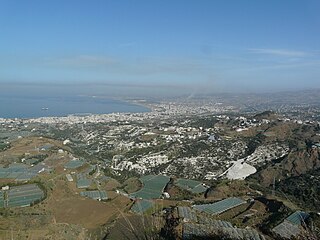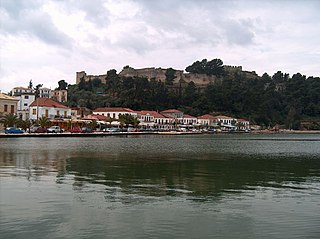Ceramus or Keramos was a city on the north coast of the Ceramic Gulf—named after this city—in Caria, in southwest Asia Minor; its ruins can be found outside the modern village of Ören, Muğla Province, Turkey.

Thelepte was a city in the Roman province of Byzacena, now in western Tunisia. It is located 5 km from the modern town of Fériana, near the border with Algeria, at around 34°58′33″N8°35′38″E.
Pacandus was considered a Roman Catholic Titular bishopric, recorded, using its adjectival form Pacanden(sis)"' in the list of such sees as late as 1884, when it was suppressed as never having existed as a residential see. One holder of the title was Mgr Léon Livinhac, superior general of the White Fathers.
Dometiopolis was a city in the Roman province of Isauria in Asia Minor. Its ruins are found in the village of Katranlı, formerly Dindebul.
Calynda was a city in ancient Caria.

Lyrbe was a city and episcopal see in the Roman province of Pamphylia Prima and is now a titular see.

Byllis or Bullis or Boullis (Βουλλίς) was an ancient city located in the region of Illyria. The remains of Byllis are situated north-east of Vlorë, 25 kilometers from the sea in Hekal, Fier County, Albania.
Sidyma, was a town of ancient Lycia, at what is now the small village of Dudurga Asari in Muğla Province, Turkey. It lies on the southern slope of Mount Cragus, to the north-west of the mouth of the Xanthus.
Euroea in Phoenicia was a city in the late Roman province of Phoenicia Secunda. today Hawarin, north of al-Qaryatayn and on the road from Damascus to Palmyra. There are ruins of a Roman castellum and of a basilica.

Mosynopolis, of which only ruins now remain in Greek Thrace, was a city in the Roman province of Rhodope, which was known until the 9th century as Maximianopolis (Μαξιμιανούπολις) or, to distinguish it from other cities of the same name, as Maximianopolis in Rhodope.
Synaus was a city in the Roman province of Phrygia Pacatiana, now Simav, Kütahya Province, Turkey.
Drizipara now Karıştıran (Büyükkarıştıran) in Lüleburgaz district was a city and a residential episcopal see in the Roman province of Europa in the civil diocese of Thrace. It is now a titular see of the Catholic Church.
Hauara was at one time reckoned as a Catholic titular see. The original diocese was in Palestina Tertia, a suffragan of Petra. It is no longer included among the titular sees listed in the Annuario Pontificio.
Dalisandus or Dalisandos was a city in Isauria, near the river Cydnus. It is considered to have been near Sınabiç, 6 km north of Claudiopolis, Turkey.

Baniyas is a city in Tartous Governorate, northwestern Syria, located 55 km south of Latakia and 35 km north of Tartous.
The former residential episcopal see of Dodona, situated in the Roman province of Epirus Vetus, is now a titular see of the Catholic Church.
Although this town in Lycia appeared in Smith's Dictionary of Greek and Roman Geography (1854) under the name Podalaea, the more recent Princeton Encyclopedia of Classical Sites (1976) calls it Podalia. The form "Podalia" is also what appears in the 1902 edition of the Encyclopædia Britannica, and is used by David Cunliffe Pointer.
Acalissus was a town of ancient Lycia, an early bishopric, and remains a titular see of the Roman Catholic Church. Coins were minted at Acalissus, some of which are housed at numismatic collections.
Mastaura was a town in ancient Lycia.
Erymna or Orymna was a town in Pamphylia. The form "Orymna" is that given in the Synecdemus and the Notitiae Episcopatuum. and in the ecumenical councils, but inscriptions found on the site show that the inhabitants used the form with "E". Stephanus of Byzantium stated that the form used in the Lyciaca of Alexander Polyhistor was Erymnae. The modern name of the site is Ormana, reflecting the ancient name.











